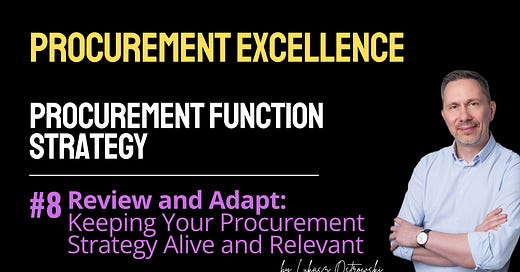Here we are - at the final piece of our Procurement Excellence series on Procurement Strategy. After the considerations on how we develop and create a procurement strategy, we now come to one of the central questions: How do we ensure our carefully crafted strategies don't end up as pretty documents gathering dust in our (virtual) drawers? 😊
And I think all of us have had the experience at some point that after the initial euphoria, the run is gradually over. Everything starts and ends with a consistent approach. Only strong consistency can keep a procurement strategy alive. From my point of view, we sometimes don't have a clear trigger for when to touch, change or renew the strategy again.
Why Regular Strategy Reviews Matter
The pace of change in our procurement world has accelerated. Think about it - how many of us had "AI implementation" as a strategic priority one or two years ago? Today, it's not just on our radar; it's reshaping how we work. This rapid evolution of our business environment makes regular strategy reviews not just important but crucial for survival.
Let me break down why this matters so much:
Market Dynamics: New technologies, geopolitical turbulence, new providers, etc. All of this influences our view of the markets.
Company Objectives Changes: Business priorities and strategic goals evolve over time. What was a top priority last quarter might need adjustment based on market conditions, financial performance, or new opportunities.
Technology Evolution: Every week brings new tools and capabilities. Do you still remember the talks about AI from 2 years ago? Today, the question is not "if" but "how" and "when".
Stakeholder Expectations: That is an essential point. Because the needs and requirements of our stakeholders are actually the main reason why we have a strategy. Stakeholders can be at different levels of the company and have clear expectations of procurement. So the trick is to cast the whole web into a transparent, robust and long-term strategy.
The Art of Strategy Review
Experience shows that effective strategy review requires a careful balance of structured analysis and creative thinking. Here's how I see it:
Regular Check-ins vs. Deep Dives: Don't wait for your annual review to realize your strategy needs updating. I recommend:
Monthly quick pulse checks
Quarterly deeper reviews of key metrics
Annual comprehensive strategy reassessment
Data-Driven Decision Making: Use concrete data to evaluate your strategy's effectiveness:
Track KPIs against initial targets
Monitor market conditions and their impact
Analyze stakeholder feedback systematically
Stakeholder Engagement: Your strategy doesn't exist in a vacuum. Regular check-ins with key stakeholders help ensure alignment:
Business unit leaders
Suppliers
Internal teams
Top management
Set Clear Review Triggers: Establish specific events that should prompt a strategy review:
Major market changes
New technology implementations
Significant supplier changes
Regulatory updates
Document Changes Effectively: Maintain a comprehensive record of all strategic adjustments:
Keep a clear record of strategy modifications
Document the reasoning behind changes
Track the impact of adjustments
Communicate Updates Clearly: Ensure transparent communication across the organization:
Share relevant changes with stakeholders
Explain the rationale behind adjustments
Ensure team alignment on new directions
Looking Forward While Staying Grounded
As we finalize our Procurement Excellence series in the context of Procurement Strategy, remember this: the most successful procurement strategies aren't the most rigid ones - they're the ones that can adapt while staying true to core objectives and support the development of the company.
In procurement, as in life, the only constant is change. Our success lies not in avoiding it, but in embracing and managing it effectively.
How do you ensure your procurement strategy stays relevant in today's fast-paced business environment?




